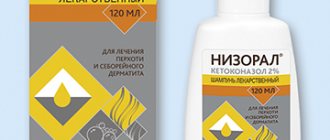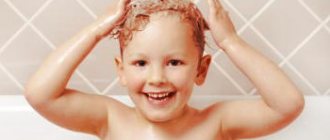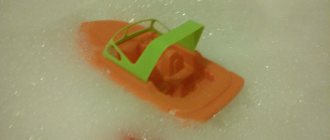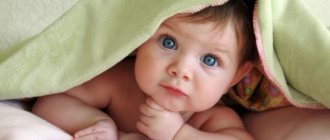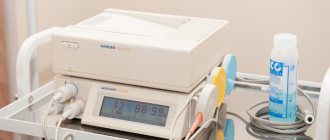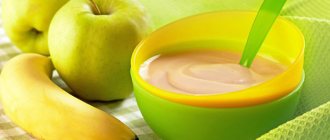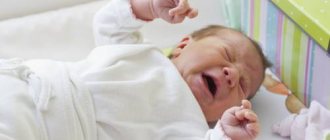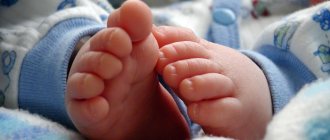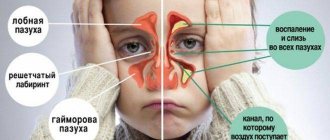Find out from the article when a crust appears on the head of newborns. How to properly remove seborrheic crusts from newborns at home.
Within a few days after birth, babies begin to develop dense crusts on their heads, and sometimes all over their bodies. They are somewhat reminiscent of seborrheic dermatitis and often cause anxiety in young parents. Some babies have more of these crusts, others have less, but they are present in absolutely all newborns. Therefore, the question of what crusts on a newborn’s head are and how to get rid of them worries many mothers. Let's figure out together what causes crusts to appear and whether they need to be treated?
What do seborrheic crusts look like in newborns?
Milk crusts or cradle caps are dense scales that merge with each other to form a dense shell. The crusts can be painted in various shades - yellow, milky, silver, white. They are hard to the touch, sit firmly on the skin, and often involve hair in their armored cap.
Scaly rashes are most often located on the head, namely in the crown area, which is why they are often called parietal crusts. But the appearance of a crust on the eyebrows of a newborn or in more inaccessible places, for example behind the ears, in the nose, on the buttocks, is also not uncommon.
The mechanism of development of seborrheic crusts in newborns
The appearance of scales on the head is explained by the immature protective function of the skin, its increased sensitivity and undeveloped resistance to external factors. The first few weeks after birth, the baby's skin adapts to the new environment and actively produces huge amounts of fat. Some kids have a lot of it, others have less. In addition, sebum can be produced in different parts of the body, so the localization of crusts in children may differ.
Milky crusts on the head of a newborn
In a newborn, the sweat glands are not fully formed, therefore, under the influence of androgens (sex hormones), they continue to develop after birth. This phase is accompanied by an increased secretion of their secretion - fat. When the glands begin to work independently, a hormonal crisis occurs in the body as a result of the release of androgens. This process lasts several weeks. It is during this period that active formation of scales is observed. When a crust appears on the head of a newborn, you can notice other signs of this hormonal crisis - a small white rash on the face, vaginal discharge in girls, peeling of the skin.
Depending on which microflora predominates on the baby’s skin, the color and structure of the scales also differ. For example, if there is a large number of yeast fungi, the scales acquire a dense and strong structure, and if representatives of the intestinal flora predominate, they acquire a softer consistency, but the color becomes rich yellow.
Birth scales adhere tightly to the baby’s skin, so they rarely come off on their own, but it is also difficult to remove them mechanically. If this is done incorrectly, the baby will experience pain and microtrauma on the skin. But if they are not removed, the crusts will dry out, becoming covered with a waxy translucent ball, reminiscent of oily seborrhea.
Milk crusts are easy to distinguish from skin diseases. They do not cause any discomfort to the baby: they do not itch, do not get wet, and do not turn red. By the age of one year, the scales usually disappear completely, provided that the baby has been provided with proper care. But there are exceptions when scales bother a child up to the age of three.
Important! Milk crusts in a baby are not a disease, but rather, on the contrary, are considered a normal physiological phenomenon. It does not require treatment, but careful care of the baby’s delicate skin is necessary.
Crusts in the nose of a newborn
Often newborn babies face problems such as difficulty breathing. The reason for this is crusts in the nose. Since their structure is as dense as that of the scales on the head, it is not possible to get rid of them with a sneeze.
To help your baby restore full breathing, it is enough to treat the nasal passages with a cotton swab dipped in any vegetable oil. When the scales get wet, the baby can easily get rid of them.
Crusts on the face of a newborn
Crusts on the face are a typical seborrheic rash in babies. The scales affect the entire facial hair (eyebrows) or other areas, including the neck. They often take on a milky, brown or yellow tint.
The scales on the face are no different from the same rashes on the head. But they create more difficulties in the process of removing them. The fact is that rough separation of the scales can leave scars on the face, so they need to be removed gradually, without applying strong force. In most cases, the crusts fall off on their own from the skin of the face when the baby is regularly washed with water.
Interesting! There is an opinion that a large number of crusts on the head prevents full hair growth. In fact, milk crusts do not affect this process in any way.
Crusts behind the ears of a newborn
In a newborn, crusts are observed behind the ears for up to a year. They actively peel off, can become very hard, and often give off an unpleasant odor. The baby is often worried about these crusts, as they can be very itchy.
They are easily removed after swimming if they have time to get wet enough. In this case, the baby does not feel discomfort, and the skin is not injured. Scales appear behind the ears even at a more mature age, in case of insufficient hygienic care in this area.
Yellow crusts in newborns - reasons for their appearance
In addition to the immaturity of the protective properties of the skin, crusts in a baby can be caused by a high concentration of female hormones responsible for the secretion of the sebaceous glands. This factor exhausts itself closer to the 8th month of life.
As mentioned above, crusts are a normal stage in the development of a small organism. But the number of scales and the duration of their stay on the skin can be aggravated for a number of reasons, including insufficient skin care, the influence of an allergic factor, and improper daily routine. Here are some of these reasons:
- Overheat. Wrapping up the baby or too high an air temperature in the children's room leads to increased sweating. The stress on the unstable function of the sebaceous glands increases the formation of scales throughout the body.
- Washing your hair too often with shampoo. Excessive contact of the delicate scalp with water and hair wash products leads to dryness and, as a result, increased secretion of the glands. This significantly increases the number of crusts on the forehead and head of a newborn. An exception to the rule: regular hair washing is necessary if the baby often sweats during sleep or feeding.
- Unsuitable cosmetic product for the body (foam, shampoo, cream). Your baby needs to choose the right body care products with a neutral pH level and natural composition. Adult shampoos, solid (including baby) soaps, and creams are not suitable. They disrupt the acid level of the mucous membranes, promote dry skin, cause irritation or allergies.
- Allergy. The baby's immune system is very unstable, so an allergic response may occur in response to any irritant. Laundry detergent, synthetic fabrics, food allergens in breast milk, diapers - all this can contribute to more extensive skin damage from milk “flakes”.
Important! Take a close look at the baby. If the crusts actively spread throughout the body, cause discomfort to the child, crack or release fluid, the development of atypical dermatitis must be excluded.
How to help your child
It is impossible to treat flaky skin of a baby with medication. In some cases (for example, with dermatitis), this is indeed necessary, but only a doctor can prescribe such therapy after taking a medical history and studying test results. You should not resort to these methods on your own.
If the cause is not critical, the parents themselves can help the baby, without medications. For example:
- If peeling is supposedly due to an allergy, first of all, you need to discard the controversial product and monitor the reaction. If the crusts are accompanied by swelling and redness, you should immediately consult a doctor.
- Peeling can be anointed with baby cream. It is oily, nourishing, and takes care of the skin. If the lesions are advanced, the epidermis is cracked, slightly red, then you should use Bepanten cream or Lanolin (mothers apply it to the nipples between feedings; this is a natural hypoallergenic healing agent).
- You can add a decoction of chamomile or calendula or herbal teas to the bathing water. There are also special bathing oils that prevent drying of the skin (for example, like Mommy Care). They will help if the baby’s forehead is already peeling, and will be useful for prevention.
Mommi Kea Bathing Oil
- The child needs to drink more. If he is breastfed, he is put to the breast more often. If it is artificial, they give more water. Often the skin is dry from a lack of moisture inside, especially in the summer.
- When peeling appears due to illness, the best help that parents can provide is to follow all the instructions of the treating pediatrician.
Important! Under no circumstances should you tear off the loose skin. If it interferes too much, lubricate it with oil. After some time, the treated area is gently, without pressure, wiped with a regular napkin.
How to prevent the appearance of milk crusts in a newborn
Doctors assure that seborrheic crusts are a harmless phenomenon and do not harm children's health. Therefore, this should be regarded not as a pathology that needs to be treated, but as an individual characteristic of a newborn baby. The only thing that is required from parents is regular and careful skin care, followed by combing out the crusts, as well as preventing their reoccurrence.
Here is what pediatricians advise young mothers to prevent cradle cap:
- Avoid overheating. Do not put a lot of clothes on your baby, especially in a warm room, and do not use hats with a synthetic composition.
- Try to maintain a sufficient level of humidity in the room. If your home has central heating, use a humidifier in the winter.
- Wash your head and body properly. Use shampoo no more than once a week. It is also worth limiting the use of foam or soap on the skin - a newborn baby can be washed in boiled water, and soap can be used 2-3 times a week.
- For your head, buy a comb made from natural materials. Even if there are no hairs yet, you can massage your head with soft fibers to improve blood circulation. This accelerates the adaptation process in the sebaceous glands.
- Follow the rules of child hygiene. It is important to bathe your baby every day, especially if your baby sweats a lot.
Milk crusts are a normal and quickly passing phenomenon during the newborn period. But given the ugly appearance and unpleasant smell, mothers try to get rid of the crusts as quickly as possible. But you need to do this slowly and carefully so as not to harm your baby.
https://youtu.be/Cr1zIK36Huo
Diagnosis of peeling
Sometimes even normal infant peeling looks scary. Since not every such case requires running to the doctor, the primary diagnosis is always carried out by the parent. It depends on her what to do next. You need to act in the following order:
- Examine the affected area to see if there is any swelling or severe redness. The crusts may be white or yellowish, but they should not smell or itch.
- Assess the general condition of the child. How he eats, sleeps and behaves during periods of wakefulness.
- Assess how long the infant’s forehead has been peeling: is this due to the introduction of complementary foods or a new medicine?
If a child is 1 month old and a crust appears on his forehead, then this is almost certainly an adaptation. If there is redness or inflammation around it, then most likely it is an allergy. It’s bad if the peeling does not go away for a long time, if rough spots appear. Then we can assume that it is dermatitis.
If the baby has a rough forehead, but the condition is not critical, presumably not associated with any disease or pathology, you can try to help the baby yourself. If any controversial issues arise or you feel unwell, you should visit a doctor with your baby.


